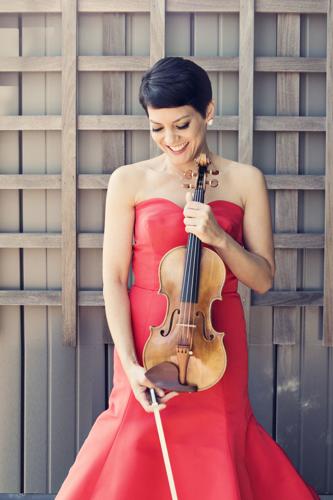At the end of the first movement of Beethoven’s beastly virtuosic and beautifully drawn-out Violin Concerto on Friday night, the Tucson Symphony Orchestra audience burst into applause.
Violinist Anne Akiko Meyers nodded her head in thanks and once they had quieted after a few moments, she shot them a smile that radiated in the darkened Tucson Music Hall.
“But wait,” she told the crowd of about 1,300 attending the opening concert of the orchestra’s historic 90th season. “There’s more.”
That was only the first movement, 25 minutes or so of dazzling virtuosic play where Meyers’ fingers danced at an exhilarating pace along the lower end of fret of her violin as she coaxed the sweet high notes of Beethoven’s concerto.
The first half of the concerto placed the soloist on near equal footing with the orchestra, which complemented Meyers’ higher octaves with more muscular bass lines. At times Meyers played so gently that it seemed the orchestra could easily drown her out, but TSO Music Director José Luis Gomez never let that happen. He balanced the exclamatory bursts of the brass that rang out in the hall with the sweeping serenity of the strings.
In the second and third movements, which meshed as one with no discernible break in the action, Meyers seemed almost lost in the music. She rocked back and forth atop inch-high wedge shoes, closed her eyes and created clarion high notes that lingered. During solo passages, she played so many notes, one on top of another, that it sounded as if there were two or three violins chiming in.
That’s the beauty and the beast of the Beethoven; there’s so much going on, you half expected the music to get swept up in some whirlwind of distraction. But Meyers brought out the distinct personality of every note, going from quivering uncertainty to determined assertion. It was breathtaking to watch.
During the intermission, Meyers, a celebrated violinist worldwide and a prolific recording artist with more than 30 recordings since her debut in 1988, signed CDs in the Music Hall lobby. There were still a handful of audience members waiting in line when the lights flashed signaling the start of the concert’s second half.
And you didn’t want to be late for that.
Gomez led the orchestra in a brilliantly exciting performance of Richard Strauss’s all-too-familiar “Also sprach Zarathustra,” the 1896 tone poem used in Stanley Kubrick’s 1968 film “2001: A Space Odyssey.”
From the opening rumble of the percussion and the clarion call of the trumpet, Gomez brought out the drama and excitement that has come to define the work. The percussion intro rambled and roared, but gently enough that it sounded for a split second like a tummy rumbling. He introduced the strings, which added a glorious cinematic sweep that was soon swallowed up in the baritone blasts from the tuba and the pulsating punchlines of the drum.
With that, Gomez and the orchestra played with shattering intensity; it was exciting and dramatic and frenzied to the point you felt sure from your place in the audience that Gomez and his talented orchestra would surely go off the rails. When the piece calms, your adrenaline is racing and the soothing brightness of the strings that flash back to the opening intro — that famous thump, thump thump that played so well in Kubrick’s film — before Gomez jolted us back with a shattering percussive exclamation point.
We expected Gomez and the orchestra would end the Strauss with grandiose flare. Instead, he drew it to a quiet close and dropped his head to his chest. He and the orchestra froze in place for several moments as the audience held its breath, half-expecting the music to come crashing back.
When he and the players looked up and broke the dramatic stillness, the audience burst into applause and shouts of praise.
Gomez and the orchestra extended Friday night’s concert with an encore of Strauss’s “Blue Danube” Waltz, which also appeared in “Space Odyssey.” When they finished and Gomez took a bow with the orchestra, he left the stage only to return a few seconds later and appear to give in to the idea of playing a second encore.
He stood before the orchestra, raised his baton, then turned to the audience.
“Just kidding,” he said, then led Concertmaster Lauren Roth off the stage with the rest of the orchestra following.
The concert repeats at 2 p.m. Sunday at Tucson Music Hall, 260 S. Church Ave. For tickets and information, visit tucsonsymphony.org





